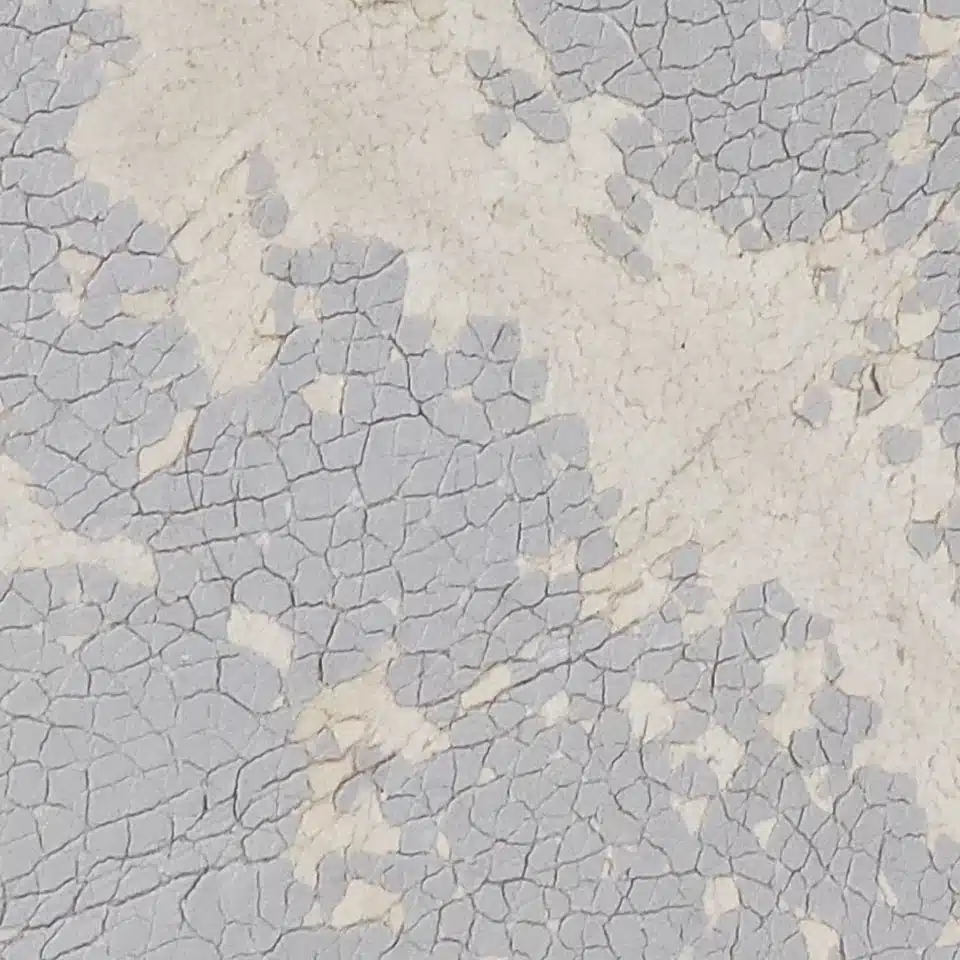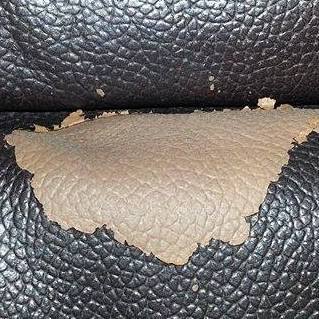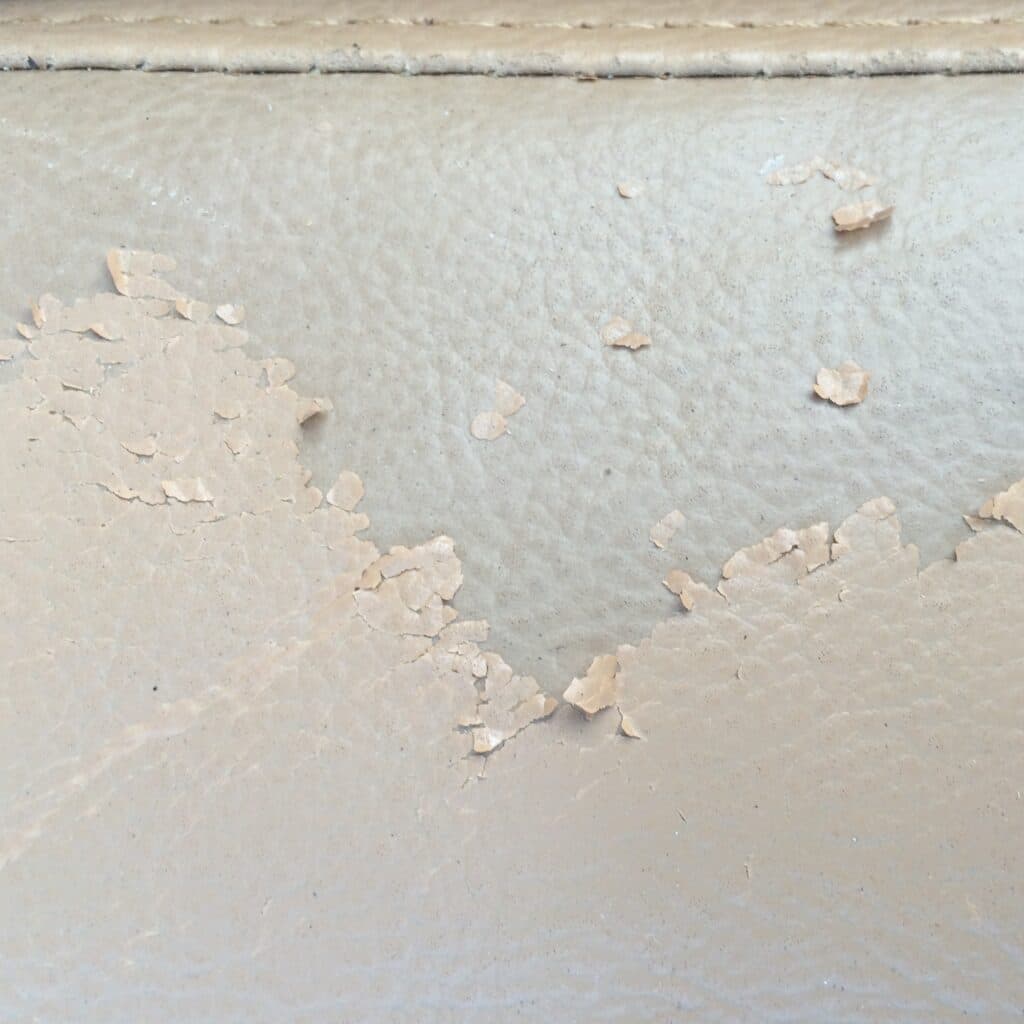Peeling or flaking is usually a sign of a delaminating bicast, bonded or faux leather and may be cost prohibitive to repair. Sometimes, however, peeling or flaking is just a damaged finish (paint) on real leather or vinyl that is easily corrected.
Look at the area that has chipped away. If a woven fabric or microfiber (but not real suede) is exposed and absorbs water, it’s a composite or synthetic that is delaminating. If the material and grain are intact, and water beads on the surface, it just needs refinishing.




Learn about peeling faux leather here.
Learn how to fix leather or vinyl with a damaged finish.
Peeling Bicast, Bonded or Faux Leather
These synthetics made from split hide, ground-up scrap leather, or polyester and coated in polyurethane. These are not the same as vinyl (PVC). They are to leather what particle board is to wood. They are notorious for delaminating – something the industry recognizes and dubs “hydrolysis-related failure”. Repairs are likely to suffer the same fate. Learn how to repair, why we don’t recommend it, and our affordable alternative here.
Leather or Vinyl With a Damaged Finish
These can be corrected with solvents and sandpaper.
- Try blending the damaged finish with denatured alcohol or lacquer thinner. Acetone is a last resort and should be used with caution. Test the solvents first in an inconspicuous area and see how well they work. Some coatings or finishes may turn into gooey mess, forcing you to strip the whole piece. In this case, sanding may be the preferred method.
- Wet-or-dry sandpaper will not gum up like regular sandpaper. Do not use anything coarser than 220 grit for leather or vinyl. Take care around stitching.
- If any suede is exposed or the surface chafed as a result of stripping or sanding, a thin coat of filler should be applied to restore integrity to the fiber. This usually is not necessary.
- Once the surface feels stable and uniform, you can restore the appearance with Rub ‘n Restore®. While our colors are technically paints, their thin, water-based acrylic formula behaves more like a dye and is more harmonious with the material than other conventional coatings. Color changes will require occasional touch-up on high-wear areas, but Rub ‘n Restore® will never peel or flake.
Good morning! I want to repaint my couches, however they’re peeling in the back where you rest your head/back. Is it good practice to scrape the peels off before repainting or just paint over it?
Thanks
Well, you have to determine if it’s a peeling finish or delaminating bonded leather. Our recommendations for the former are in this article; for the latter, please read the link and watch the video about bonded and polyurethane leathers.
The arm of our sofa is is peeling it is only 2yrs olds and only two adults use it, it’s bonded grey leather, can you recommend rubnrestore?
Not in good conscience. It’ll buy you some time, but is it worth the investment of materials and labor? Click the link above (or here) about how to repair peeling faux leather to learn why it’s a losing battle.
Hi.
Can you.use this product for leather car seats?
Yes, though typically a Custom Color is needed unless the leather is Black or 1997-2007 GM Stone interior color name (found by calling GM Parts with your VIN).
We have colour transfer on our cream suite ? It’s only sat on by 2 of us just in the evenings after bathing /showering and sitting in lounge / sleepwear ? It’s only just 3 yrs old ? It’s under warranty but there saying it don’t cover this ? Please help !!!!
Color transfer from your clothes would not be covered. We won’t guarantee our product against it either. Blue jeans are usually the culprit, not sleepwear. Depends on the type of fabric and dye used. This article about removing ink and denim dye may be of more help. A colored finish will correct it.
I have a nice set of couches, chair, and ottoman. Some have recently started cracking/peeling so I’m believed they’re bonded leather unfortunately.
I know this isn’t the best material to have and fix. But would rub and restore work on bonded leather? If so, how long?
Results vary, and we cannot make any guarantees for bonded leather. First, you need to resurface the fabric, then recolor it. This video demonstrates how and why we think it’s a futile endeavor.
We have 3 small spots that are peeling on a cushion on our couch. The cushion cannot be removed. Do we need to sand the whole cushion or just the spots?
Also does the rub affect the color?
Less is always more. Just sand the trouble spots. I don’t understand your second question “Also does the rub affect the color?” Sanding may damage the color surrounding the peeling spots, but you’ll have to refinish anyway.
I bought a real leather recliner and it has many tiny pin holes from a cat walking across all areas of the chair. they are not long scratches and they don’t really have flaps to glue down. what is the proper product and technique to repair/fill the holes? it al most seems like the holes are so small that just sanding will work but I want the chair to last and look and feel like the leather is not damaged. I will be dying the chair with your peppercorn color dye.
Do a tiny bead of super glue in each hole and sand. If the hole is too tiny to subpatch, glue won’t bleed through it and stick to the substrate either.
The faux-leather started peeling off a pair of my boots, and since they are almost new I have been researching options. I very carefully removed all of the peeling material, and discovered a lovely, almost suede-like material underneath. I love the color and the material. I want to waterproof it so I can preserve it and wear the boots without worry. I’d prefer something I can brush on so that it gets into the seam areas adequately. Is there a product you would recommend? Thank you!
Anything you apply to water-proof is going to change the texture and appearance of the faux suede. A wax is your best bet, but will need reapplication.
My dark brown leather sofa has turned lighter on one armrest. Due to body lotions or oils. Can i dye this back to its original dark color
Yes, see here about matching color.
What would you suggest to repair peeling vinyl massage table covering, chair and bolsters?
The link above that says “Learn why and check out our affordable alternative here” links to the answer to your question.
Have a three month old recliner that the top coat bubbled in a spot and when I wiped it came off the color of leather is fine how do I fix it? The company I just purchased from says peeling is not covered
If the material is intact, might just be a lousy clear finish that can be corrected. See here.
My leather sofa has what I’d describe as fluffy peeling on the surface of both seat beds. Looking at your pictures above its similar to the red sofa on the right picture. Should i use wet & dry?
Yes, try sanding and solvents as per the instructions.
Do you have any videos to show how these repair techniques are done?
There is a video demonstrating how to repair peeling leather in the link above.